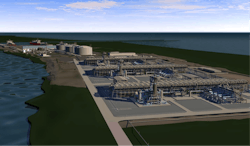Yokogawa Corporation of America receives Analyzer Systems and Shelters Order from Freeport LNG
Yokogawa Corporation of America announces that it has received orders from Freeport LNG for its Liquefaction Facility (LQF) and Pre-Treatment Facility (PTF). The total order value is $15M, which currently includes only the first two trains.
Freeport LNG is constructing liquefaction infrastructure at the existing terminal to provide nominal export capacity of approximately 13.9 million metric tonnes per annum (mtpa) of LNG, which equates to processing approximately 2.0 Bcf/d of pipeline-quality natural gas (feed gas). The feed gas will be derived from the interconnecting instrastate pipeline systems through Freeport LNG’s existing Stratton Ridge meter station.
The gas will be pretreated near Freeport LNG’s existing metering, compression and underground storage facilities. The pretreated natural gas will then be delivered to the terminal through Freeport LNG’s existing gas pipeline. At the terminal, it will be liquefied and then stored in full-containment LNG storage tanks. LNG carriers arriving via marine transit through the Freeport Harbor Channel will export LNG from the terminal.
The added liquefaction capability will not preclude the terminal from operating in vaporization and send-out mode as business conditions dictate. Also, having dual liquefaction and regasification capabilities will not result in any increase in the number of ship transits since the total amount of LNG handled, either by liquefying natural gas or by vaporizing LNG, will not exceed authorized thresholds.
The Liquefaction Process
Each of the three liquefaction trains will utilize a proprietary propane pre-cooled mixed refrigerant process, developed by Air Products and Chemicals, Inc. (Air Products), to produce a nominal 4.64 mtpa of LNG. To prepare the feed gas for liquefaction, it will be pretreated near Stratton Ridge to remove CO2 sulfur compounds, water and mercury, after which compressors will be used to increase the pressure of the natural gas for delivery to the terminal through Freeport LNG’s existing 42-inch diameter pipeline.
To convert the pretreated feed gas into LNG, the gas is first cooled with propane refrigerant, after which it is stripped of natural gas liquids (NGLs) via cryogenic distillation in the scrub column. The NGLs are, in turn, stripped of light gases (mostly methane) that are recycle through the main cryogenic heat exchanger (MCHE). Following NGL removal, the primary feed gas from the scrub column is also sent to the MCHE, where it is further cooled inside tube bundles, each made up of several tube circuits, by a lower-temperature mixed refrigerant that flows outside the tubes.
As the feed gas flows up the tubes, it starts condensing by transferring heat to the liquid/vapor mixed refrigerant, which warms up and vaporizes as it flows down the outside of the tubes. The heated mixed refrigerant is then cooled by ambient air, compressed and subsequently chilled by propane refrigerant in heat exchangers, where a portion of the refrigerant condenses. After separating the vapor and liquid streams of mixed refrigerant, both streams are depressurized and admitted to the MCHE to provide cooling for the conversion of methane-rich gas into LNG. The liquid mixed refrigerant stream is depressurized through a liquid expander to increase the overall process efficiency. The high-pressure LNG exiting the MCHE is depressurized through a liquid expander and delivered to the LNG storage tank at near-ambient pressure. Once in the storage tank, the LNG can be pumped through the plant piping to the dock to be loaded onto ships for export.
Project Status and Schedule
Freeport LNG started construction of the liquefaction project in November 2014 and expects to achieve commercial operation of the first liquefaction train in 2018.
Freeport LNG had engaged a joint venture of CB&I and Zachry Industrial to develop a fixedprice turnkey contract price and detailed scope for the project’s EPC agreements. The final EPC contract with the joint venture to construct the first two trains of the liquefaction project was, signed in December 2013. For the third-train EPC contract, joint venture partners CB&I and Zachry were joined by Chiyoda International Corporation, and the contract was awarded in March 2015.
Freeport LNG selected Air Products and Chemicals, Inc. (APCI) as the liquefaction technology provider for its experience and overall performance of its proprietary cryogenic liquefaction process (C3MR). Over the last four decades, APCI has designed and manufactured over 100 main cryogenic heat exchangers for LNG projects around the globe.
Following financial closing on trains 1 and 2 in November 2014 and on train 3 in April 2015, all three units are now under construction by a joint venture among CB&I, Inc., Zachry Industrial, Inc. and Chiyoda International Corporation.
The first two trains are on schedule to commence operations by September 2018 and February 2019, respectively. The third train is expected to be in operation approximately six months following the second train, or in August 2019.
Key Milestone Activities Status / Date
Liquefaction Tolling Agreements (Train 1) with Osaka Gas and Chubu Electric - July 2012
Liquefaction Tolling Agreement (Train 2) with BP Energy Company - February 2013
Liquefaction Tolling Agreements (Train 3) with Toshiba Corporation and SK EKS - September 2013
DOE’s Authorization to Export Entire Contracted LNG Volume of Initial Three Trains - November 2013
Trains 1 and 2 EPC Contracts Finalized - December 2013
FERC’s Issuance of Authorization to Construct and Operate - July 2014
Final Approvals from DOE and FERC - November 2014
Trains 1 and 2 FID/Financial Close - November 2014
Commencement of Construction - November 2014
Train 3 EPC Contract Executed - March 2015
Train 3 Financial Close - April 2015
Liquefaction Train 1 In-Service Date - September 2018
Liquefaction Train 2 In-Service Date - February 2019
Liquefaction Train 3 In-Service Date - August 2019
>>For more information, click here.

